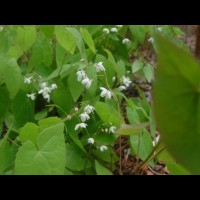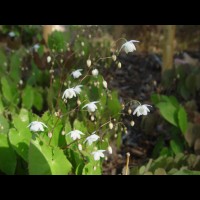Epimedium x setosum
Now considered an ancient, yet stable, fertile hybrid between E. diphyllum and E. sempervirens. Found in areas surrounding the Seto (thus setosum) Inland Sea, on Honshu and Kyushu, Japan. Evergreen, with medium-sized leaflets and a many-flowered inflorescence. Blooms along with the grandiflorums. Flowers similar to those of E. diphyllum, but more numerous, held on sprays above the foliage. Generally much larger than E. diphyllum, although most of the clones in cultivation are half the normal size, probably selected for their “less plant versus more flowers” ratio. These clones do not produce a second flush of leaves. Clump-forming.
Epimedium x setosum Cc. 950163
E. x setosum (Cc. 950163)
This is the typical form of this naturally occurring fertile hybrid collected in northern Kyushu, Japan. It is larger overall than others in commerce, growing up to 12” tall, with larger leaflets. Small white flowers are produced in sprays above the leaves that may appear bronzed in spring/fall. Semi-evergreen.
E x setosum Cc 960059
E. x setosum (Cc. 960059)
A very floriferous clone from the garden of Harold Epstein. Medium-sized leaflets with prominently spined margins on plants literally covered with numerous sprays of white flowers. 8-10” tall. Semi-evergreen foliage sports a reddish fall color. A favorite of the clones we grow, but each possesses individual charm.

